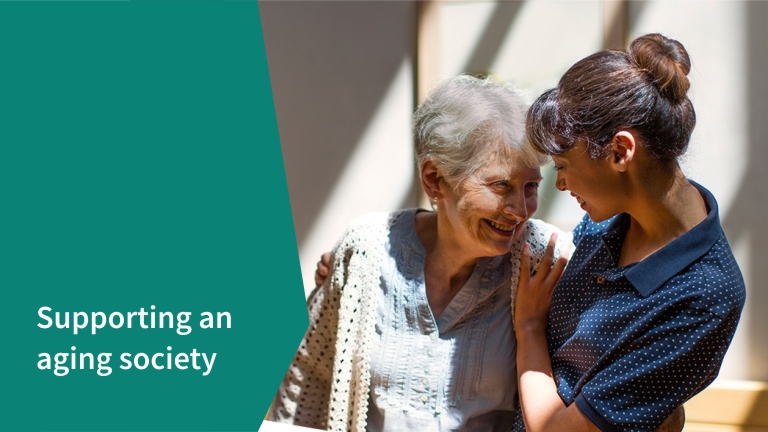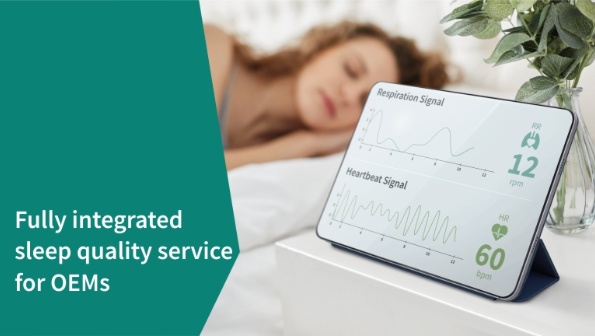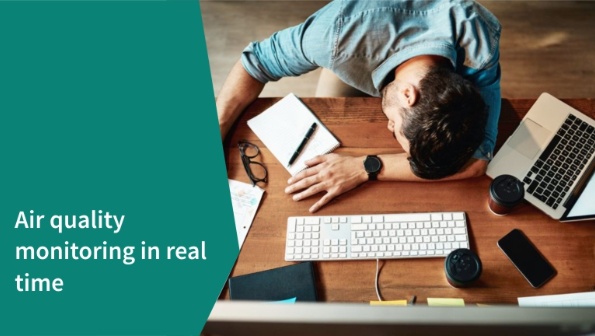
Mastering the challenges in the healthcare system - with semiconductor solutions for smart health devices
Smart technology for smarter health choices
Enabling new smart health and fitness technologies
Good health increasingly means taking responsibility for our long-term care rather than sporadically treating acute illnesses. It places great emphasis on increasing wellbeing, improving fitness, diet, appearance, sleep and mindfulness to prevent illness. It recognizes the role of the home as an important factor in individual health promotion and - in the event of illness - care. It enables patients to gain an overview of important health data themselves and encourages them to reflect on this with their doctor and derive suitable preventative measures from it. Necessary health data can be transmitted directly to the doctor via digital applications - for example in the case of diabetes and high blood pressure. This makes it more efficient and leads to faster results for patients - without losing sight of data security, of course.
Infineon’s portfolio of innovative and state-of-the-art semiconductor solutions support the design of innovative technologies and devices for smart health monitoring, for example medical wearables, preventive healthcare appliances like sleep monitoring and, in the event of illness: solutions for assisted living at home. Sensors, connectivity technologies and security solutions enable massive improvements in secured, efficient, convenient and patient centered health and well-being solutions as well as services for patient engagement.
Even though medical devices consist of a lot of technical know-how, the focus of smart health devices is always on people and their needs. It is about empowering people to have a better and healthier life.
Smart tech unlocking a healthier you
Because our health deserves the very best
Smart health devices can help improve health, fitness, nutrition, sleep, and mindfulness. Innovative microelectronics make it possible.
The main focus of the digitalization of healthcare is to help patients take responsibility and manage their own health matters. The latest high-tech devices are completely changing the way we can monitor and improve our own health status, take preventative measures against chronic diseases, and interact with healthcare professionals. Patients can become aware of the smallest changes in their health, monitor their vital signs and know what they should do to live well.
Revolutionizing healthcare: An AI powered smart Stethoscope
Eko Health is revolutionizing healthcare by transforming the traditional stethoscope into an AI-powered disease detection platform. Learn how Eko Health uses Infineon's PSoC 6 to create a Bluetooth-enabled smart stethoscope that combines high-end computing performance with low power consumption. Watch the video and discover the innovative technology behind this groundbreaking medical device.
No more migraines: First remote electrical neuromodulation device for migraine care

Theranica, a digital therapeutics company based in Netanya, Israel, and Bridgewater NJ, USA, has developed Nerivio, a groundbreaking remote electrical neuromodulation (REN) wearable device for migraine care. In principle, Nerivio is an innovative neuromodulation device that stimulates key elements of the neural system to trigger pain management mechanisms in the human brain that naturally inhibit migraine-related pain or symptoms, non-invasively and without medication.
Sleep Better with Tsingray: Innovative Sleep Monitoring

Watch the YouTube video and discover, how Tsingray's vital sensing technology, enabled by Infineon's XENSIV 60 GHz radar, PSoC 6 MCU, AIROC Wi-Fi + Bluetooth Combos, and OPTIGA Trust B solutions, is revolutionizing smart health and safety. Learn how this cutting-edge technology detects respiratory and heart beating signals, and recognizes sleep stages with accuracy.
Oura Ring: Smart ring for fitness, sleep and health monitoring
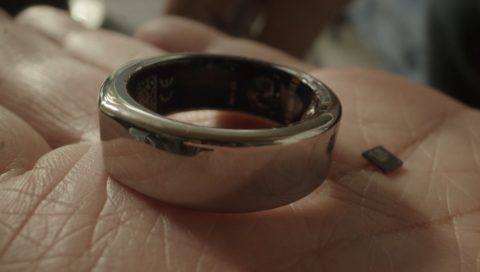
The Oura Ring is an innovative wearable that helps you monitor and improve health. Sleep, readiness, and activity - these scores tell you how your body feels and what your body needs, every second of every day. You'll know when you need more sleep, when you might be getting sick, when it's time to push yourself - and more - with a personalized experience on the Oura App.
The Oura Ring requires long-lasting battery life, increased processing capacity, and the use of advanced sensors, all in a stylish and comfortable form factor. This innovation is delivered through Infineon's PSoC™ 6 MCUs.
Supporting an aging society
Smart tech can support a healthy, independent living
People worldwide are living longer. Today most people can expect to live into their sixties and beyond. At the same time, diseases such as diabetes, cardiovascular diseases, and sleep disorders are on the rise. This makes it all the more important to relieve the burden on the healthcare system with smart technologies that help us stay healthy and fit for longer - and allow us to live independently at home for longer even in the event of illness.
We live in a world of rising population. The latest projections by the United Nations suggest, that the global population is expected to continue growing for another 50 – 60 years, reaching a peak of around 10.3 billion people in the mid-2080s. At the same time, life expectancy is increasing – the average longevity is projected to reach around 77.4 years globally in 2054. By the late 2070s, the global population aged 65 and older is projected to reach 2.2 billion.[1] This development presents us with challenges: Everybody wants to live healthy, vital, and as independently as possible into old age.
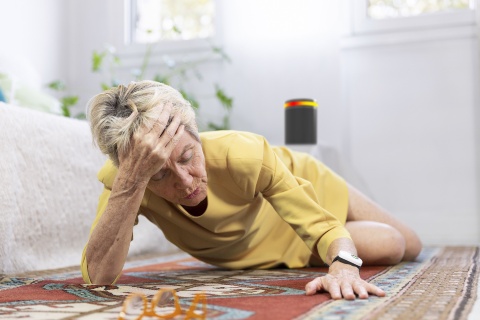
The increase in chronic diseases and health problems in our society often entails the need for home care or self-treatment at home. The desire for a self-determined life is just as decisive for this as the lack of suitable facilities in some regions. This is where the smart home can help with home automation and health monitoring solutions.
With smart speakers becoming the central control hubs of smart houses, presence detection enabled by a radar sensor allows OEMs to provide advanced, innovative features to differentiate their products in this highly competitive and rapidly growing market segment. Adding a radar sensor can improve the user experience by sensing the “real” presence and location of a person. Because it can detect the direction of movement (angle of arrival), the smart speaker for example is now aware that someone is approaching so that it can power up the VUI and internet connection to be ready to listen for commands. There is now no longer a need for a ‘wake up’ word.
Health monitoring features for smart speakers enabled by radar sensors
The amazing sensitivity of a radar sensor enables smart speakers to have new features for health monitoring. This is an exciting new area that address the growing awareness of the importance of health monitoring as can be seen by fitness trackers and the features built into smart watches such as exercise, sleep and heart monitoring. Thanks to a radar sensor’s sensitivity, which can even detect a pulse in a wrist, there are now many health monitoring opportunities that can be designed into a smart speaker with a radar sensor to add user value with hardly any impact on the system costs as these are all in software.
Examples are the use cases of fall detection, unobtrusive monitoring of elderly people who unexpectedly change their daily routines so that they can be checked in case of a problem, monitoring of respiration rate, irregularities in heart rate patterns as an early warning of a possible problem, and even coughing or snoring. All of which can be done automatically eliminating the problem when the elderly person forgets to wear the monitoring device.

There is no doubt about how important good sleep is for physical and mental well-being. The quality of sleep affects how fit and efficient one is during the day. Sleep even affects the risk of developing lifestyle diseases such as obesity, depression and type2 diabetes. Unfortunately, many people struggle with intermittent or even regular sleep problems. Finding out the reason for this often proves difficult. Sleep monitoring can help here to measure the quality of sleep and gain valuable insights into individual sleep patterns.
Infineon’s next generation radar based XENSIV™ Sleep Quality Service is a fully integrated hardware and software solution for OEMs to help improve people’s sleep.
Radar solutions are a key enabler for the digitalization of medical healthcare in sleep improvement solutions like the solutions of Sleepiz or Tsingray.
The biggest highlight of the Tsingray device is the adoption of millimeter-wave radar tomography sensing technology pioneered in the industry. With 2.5cm resolution chromatography and 100ms refresh period, it can monitor from multiple dimensions such as sleep, breathing, heart rate, body movement, sleeping posture, etc., that is, all the micro-motion data of the monitored person during sleep can be completely recorded.
How do Infineon’s products contribute to this innovative Tsingray solution?
The smart sleep breathing monitoring device, using Infineon’s XENSIV™ mm-wave 60GHz radar chip, has recently been included in the cooperation of Tsingray with JD Health. This device is now part of a healthcare online service package for sleep quality improvement of "JD.com”, a huge online trading platform based in Greater China. In addition to Infineon’s XENSIV™ millimeter-wave radar chip, Tsingray is also adopting Infineon's Wi-Fi/BLE, PSoC MCU and OPTIGA™ Trust B security chip solutions for the development of next-generation products of this sleep monitor.
With the support of Infineon’s XENSIV 60GHz mm-wave radar chip, the smart sleep breathing monitoring device is capable of realizing:
- Non-contact and non-sensitive continuous sleep monitoring and collection of real-time data all night long without affecting sleep.
- Accurate perception of vital signs and body movement micro-data of the whole sleep process, and multi-dimensional sleep monitoring by mm-wave chromatography.
- Automatic generation of monitoring reports providing data reference for customized sleep improvement plans, expert consultation, follow-up visits
- Diagnosis of sleep problems by AI auxiliary diagnosis and treatment system.
- Measurement of distance between objects with mm level precision with lower power consumption and minimal volume.
- Non-contact monitoring method, which avoids users’ discomfort, making the device very suitable for long-term home monitoring.
- Timely warning of sudden sleep death omens, long-term apnea and other dangers, which fills the gap of accurate monitoring of nighttime breathing patterns and heartbeat patterns.
- Support of the diagnosis of chronic breathing diseases such as chronic obstructive pulmonary disease, asthma, apnea and hypoventilation.
Easy and intuitive health monitoring everywhere
Health and fitness wearables
The more we focus on our health and fitness, the more we realize how important it is to keep an eye on our health and fitness data at all times. Small wearable devices allow us to do just that - in an easy, intuitive way.
Health and fitness wearables such as smartwatches, sports watches, fitness trackers and healthcare wristbands can be comfortably and discreetly worn on the body and support a growing number of use cases, including health and fitness tracking. Equipped with health monitoring functionalities, wearables can measure physical activity and vital parameters such as heart rate, blood pressure or blood oxygen levels.
In addition to the “classic” wearables for measuring fitness values like smartwatches, sport watches or fitness tracker, more and more new, innovative formats such as rings or other jewellery, are entering the market. Smaller, more inconspicuous, more individual, they pose great challenges to manufacturers in terms of storage capacity, battery life, handling, precision, reliability, security, etc. Users expect a beautiful design with the same or even better functionality and reliable and easy handling.
Oura Ring. Smart ring for fitness, stress, sleep & health monitoring.
The Oura Ring is an innovative wearable that helps you monitor and improve health. Sleep, readiness, and activity - these scores tell you how your body feels and what your body needs, every second of every day. You'll know when you need more sleep, when you might be getting sick, when it's time to push yourself - and more - with a personalized experience on the Oura App.
The Oura Ring requires long-lasting battery life, increased processing capacity, and the use of advanced sensors, all in a stylish and comfortable form factor. This innovation is delivered through PSoC™ 6 MCUs, enabling features like a small form factor, data storage, Bluetooth low energy, extended battery life, sensor fusion, and data processing.
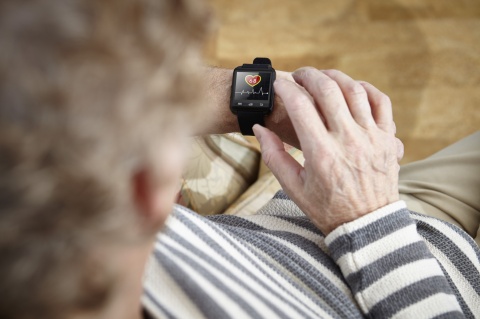
Wrist-worn health bands are becoming more and more popular among elderly people. Medical bands offer a range of health-monitoring features that keep users updated about their health status in real-time. In addition to general health and activity tracking, they can also help users to manage underlying diseases or chronic conditions by connecting with telehealth services and transmitting specific health metrics such as heart rate, blood pressure, and blood sugar levels to a healthcare provider of their choice. Location and fall detection can add another safety net. All of which can enable elderly people to live safely and independently – for longer.
Everything it takes for safe, secure and reliable healthcare bands
Click here to learn more about our extensive portfolio covers all sensing, computing, memory, power and connectivity building blocks needed to create safe, reliable wrist-worn healthcare devices.
Protecting sensitive health data
Healthcare privacy and security
In recent decades, the use of digital technologies in health and lifestyle has advanced exponentially. The potential applications are many: imaging for diagnosis, electronic health cards, robotics in surgical procedures, telemedicine, home and mobile monitoring devices to monitor the health of individuals. This increase in digitalization makes the safeguarding of health and patient data urgent and is a basic requirement for the functioning of the digital health system.

Equipping smart health appliances with the right security solutions from the get-go is key to helping prevent attacks – whether theft, fraud or manipulation. Companies who are looking for a security solution need one that is equally easy to use – in terms of fast integration and time to market – and trustworthy. Unlike software-only solutions a hardware-based solution is strong, tamperproof and provides a solid foundation. Infineon's independently-certified hardware security solutions are pre-integrated and therefore easy to integrate into your system. The OPTIGA™ Trust and OPTIGA™ Authenticate S solutions protect the storage and transfer of highly sensitive personal healthcare data.
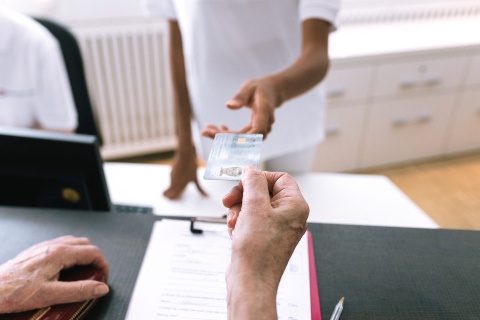
Worldwide, healthcare fraud costs insurance authorities and companies hundreds of millions of dollars every year. With conventional systems based on paper or memory cards, it is difficult for authorities to ascertain whether the patient or user is actually the insured.
Enhancing fraud prevention with electronic health cards
While electronic health cards promise greater convenience and an improved patient experience, e-health cards must ensure that personal medical records do not fall into the wrong hands.
Electronic health cards are becoming an increasingly effective way of preventing fraud – particularly as they evolve towards more sophisticated identification mechanisms such as biometrics. E-health cards have the potential to improve the patient experience by storing key medical data and medication history, and by serving as an electronic prescription. These cards can also be used to securely store social security numbers.
Given the sensitive nature of medical data stored on e-health cards, they must offer robust protection of privacy. Widespread adoption also calls for ease of administration and – most importantly – a mature telematics infrastructure to network all players in the care continuum and enable dynamic updates of data and functionality.
Leading technologies for tomorrow’s eHealth cards
Customers value in particular the ability of our controllers to protect sensitive data, while delivering the memory, performance and cost efficiency required for future-proof electronic health cards. The SLE 78 features Integrity Guard, for instance, a self-checking dual CPU which not only stores, but also internally processes sensitive data in encrypted form.
Designed specifically to ease security implementations and certification processes, Integrity Guard combined with our SOLID FLASH™ memory radically reduces cost of ownership by accelerating time to market.
For ease of deployment, we also deliver fully integrated software solutions on native or on Java platforms.
The future of health is smart – Are you ready to innovate?
Get ready to shape the future of health tech

We support a health-conscious lifestyle by enabling smart devices that can help improve well-being and stay healthy longer. With innovative microelectronics we make these digital health appliances reliable, convenient, personalized - and secured. That's our contribution to a functioning healthcare system facing a rising global population and aging.
Our semiconductor products and software solutions are the perfect match for smart health appliances as they meet the needs of digital healthcare devices. Discover how you can build smart health applications – better and faster – with our IoT products and solutions.
- Ultra Low Power Feature does matter: Enabling longer battery lifetime
- Robust and Reliable Connection is a must: Best user experience by no connection drops
- Highly Integrated and Reference Design: High Performance BLE platform
- Product Security and Authentication: Enabling data security and product authentication
- Precision is a prerequisite: Enabling high-precision monitoring solutions based on radar technology
SENSE: Sensors are the basis for measuring the state of health
XENSIV™ MEMS microphones introduce a new performance class for MEMS microphones. The portfolio of XENSIV™ MEMS microphone-based reference designs and Infineon inside MEMS microphones will propel audio performance to the next level for even the most demanding applications.
The XENSIV™ family comprises digital, barometric absolute pressure sensors that impress with their small size, low power consumption, highest precision, environmental robustness and relative accuracy over a wide temperature range. Explore our Infineon inside pressure sensor partner products to find the ideal solution for your needs.
Health monitoring, gesture control, and presence detection are among the applications for which Infineon’s 60 GHz radar is a versatile solution, while Infineon’s REAL3™ image sensors are the right choice for authentication via face recognition and AR/VR applications. They are based on Infineon ToF (time of flight), which is the most advanced vision-sensing technology in the world today.
Yet smart things also rely on physical interaction between users and devices. Infineon’s CAPSENSE™ solutions bring elegant, reliable, and easy-to-use capacitive-touch sensing functionality to your design. CAPSENSE™ boasts industry-leading low-power operation, with an average current consumption of 22 µA.
COMPUTE: Microcontrollers and high-performance memory solutions bridging the gap between high performance and low power
The PSoC™ 6 MCU contains a dual CPU architecture, with both CPUs on a single chip. Beyond the low-power core, the PSoC™ 6 programmable processor line has six power modes for fine-grained power management. Built-in security protects your IoT system.
Matching the PSoC™ 6 family, EXCELON™ – the next-generation Ferroelectric RAM – combines ultra-low-power operation with high-speed interfaces, instant nonvolatility, and unlimited read/write cycle endurance, making it the ideal data-logging memory for portable medical, wearable applications.
We expect our smart things to work anytime, anywhere. At the same time, they should offer maximum safety, reliability, and security. Rely on our broad portfolio of safe, secured, and reliable solutions for embedded systems for embedded systems and check out our NOR Flash products.
ACTUATE: From Qi transmitter to Class D amplifier
These include customized turnkey system solutions containing software, such as the 15 W Qi table-top transmitter or the 2.5 W resonant multi-device charger with transmitter and receiver solutions.
For great-sounding products, Infineon's MERUS™ multilevel Class D amplifier ICs boast superior energy efficiency and power density. Infineon’s portfolio includes fully integrated single-chip audio solutions alongside discrete audio solutions with highly scalable amplifier driver IC and power MOSFET combinations.
CONNECT: From Bluetooth to 5G - Connectivity on demand
To ensure flexible connectivity worldwide, Infineon offers a wide range of high-quality 5G-ready eSIM solutions ranging from eSIM hardware to high-end, ready-to-connect bundles like OPTIGA™ Connect. Combining certified, best-in-class security hardware with a fast, interoperable operating system (OS), OPTIGA™ Connect solutions are optimized for the requirements of the IoT and consumer devices. Pre-integrated connectivity and remote profile provisioning capabilities support fast and easy deployment and management of connected devices the world over.
The WICED Wi-Fi + Bluetooth combos are a small-form-factor solution for IoT designs and integrate IEEE 802.11a/b/g/n/ac WLAN and Bluetooth into a single-chip. Many of the Wi-Fi + Bluetooth combos are supported on WICED Wi-Fi and ModusToolboxTM software development kits that provide code examples, tools, and development support.
SECURE: Creating trust in the digital world of healthcare and medical devices
SECORA™ Connect is an all-in-one, turnkey solution that turns the respective wearable or IoT device into a powerful and versatile wallet for securely storing, selecting, and using multiple payment cards or transport tickets, for instance. SECORA™ Connect allows designers of smart wearable systems with no security or antenna design experience to seamlessly integrate a very compact solution with ultra-low power consumption for various NFC-based applications.
SECORA™ Blockchain is a fast, easy-to-use Java Card™ solution boasting best-in-class security for blockchain system implementation. By providing a safe “vault” for user credentials, SECORA™ Blockchain can reduce the end user’s commercial risk and helps to increase trust in the blockchain system.
Last, but not least, the OPTIGA™ Trust, OPTIGA™ Authenticate and OPTIGA™ Connect product families offer a full range of security chips to address individual needs in the field of embedded authentication, brand protection, and advanced security applications.
Sources
[1] United Nations (2024). World Population Prospects 2024: Summary of Results. UN DESA/POP/2024/TR/NO. 9. New York: United Nations.
2) United Nations: Sustainable Development Goals; https://unric.org/en/sdg-3/



